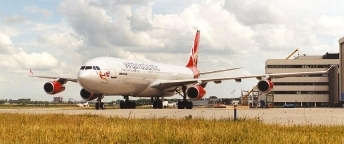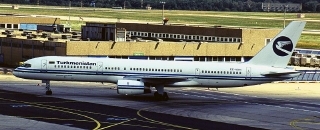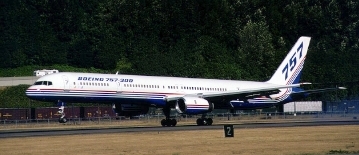NOTE: THIS PAGE HAS A LOT OF GRAPHICS.
PLEASE BE PATIENT AS THE PAGE LOADS.
updated 2/20/2000
THE AIRPLANE AND AIRLINES PAGE
(...continued...)
My "planes on the brain" narrative continues here with the more significant jetliners developed in the
Western hemisphere. I have briefly covered what I consider to be two jetliners that made the biggest
contribution to air travel in our generation (aside from the Boeing 707, which is covered in the next section,
see Site Map). The airliners covered here have made airline travel what it is today...through new tech-
nology (at the time of the airplane's use...many jetliners mentioned here are no longer in airline service),
or new designs. Each has its own place in commercial air transport history.
Airbus Industrie A-300
This is a really nice picture of Airbus Industrie's first
commercial jetliner, the A-300. Airbus Industrie is a con-
sortium of nations throughout the European Community
that was formed to give competition to Boeing and
McDonnell-Douglas in the world jetliner market. Their
first entry, the A-300, did not sell well in North America
yet was popular among airlines throughout the rest of the
world, particularly in Europe and the Pacific Rim nations.
This particular model of the A-300, a series 600, is an updated

version of the original design, the A-300B1. The airplane is very much like in appearance to its American
counterpart, the Boeing 767; yet can be distinguished by the graceful upswept tail design in the aft fuselage section.
Airbus Industrie A-340
The Airbus A-340 is primarily a competitor to Boeing's 747. It is an ultra-long ranged high capa-
city aircraft, powered by either the GE CFM56
or the International Aero Engines IAE V2500
turbofan engine (customer option). The airplane
can fly up to 18 hours nonstop with a full payload,
allowing for nonstop routes such as Sydney-
London or Los Angeles-Johannesburg, which were
previously unattainable, even with the 747. An
extrememly quiet and fuel efficient aircraft.

An A-340 at Amsterdam in the livery of Richard Branson's
Virgin Atlantic Airways.
THE BOEING COMPANY
SEATTLE, WASHINGTON, USA
As I am sure you can tell by now, I am a fan of the jetliners that The Boeing Commercial Airplane Group
produces. Not to detract from any other commercial airplane designed or made by another manufacturer,
but as someone who both flies on and works many different types of airplanes, the Boeing product is my
choice. I do have to add here, I was disappointed that the large order of airplanes my company placed recently
was not for the Boeing product, but for a competitor's.
Boeing's aircraft designs are classics; the lines of their aircraft are not only graceful but strong and durable.
Personally, I have been in a few situations inflight, that, while sitting in the cabin, I was really thankful
that I was on a Boeing jetliner. So, given that, I'm going to showcase all of Boeing's jetliners here as each
has its own place in commercial aviation history. In this section, two Boeing's have already been covered:
the mighty 747 and the highly prolific 727. The next section of this website covers the Boeing 707 in as
much detail as space will allow, so below are detailed the Boeing 737, 757, 767, and of course the brand
new 777.
Training is in session: you may be wondering how Boeing comes up with all the seemingly haphazard
and confusing numbering of the indiviual aircraft. A 707-349C, a 737-3B7, or a 747-221B: believe it
or not, there IS a logic to the numbering: click HERE to be taken to another website which will explain
it in great detail (NOTE: this link is and ftp site and sometimes does not work, or takes a while to load).

Boeing 757
The 757, introduced in the early 1980's and origin-
ally intended as a replacement to the aging 727,
turned out to be a jetliner with virtually no equal.
The airplane is very versatile. It can economically
fly short distance routes, such as Chicago-St. Louis,
but can also fly long haul as well, regularly oper-
ating routes such as New York-Los Angeles, et. al.,
as well as some transatlantic routes. Cargo capacity
A 757-200 of CIS carrier Turkmenistan Airlines
is also impressive for a narrowbody jetliner. Flight crews also like the 757; it is a very honest airplane to fly...
there are very few "surprises". Cabin crews and ground crews also like the airplane to work, at its cabin arrang-
ment is "worker freindly". Passengers like the 757, owing to its roomy cabin, and smooth, solid Boeing ride.

Responsive to it's customers needs as usual,
Boeing has developed a new, larger version
of the airplane, the 757-300. It is a stretch
version of the -200 with a higher passenger
and cargo capacity. The 757 is popular with
charter carriers and many charter airlines
were pinting out that the 757-200 was not
utilizing its full capabilities. So Boeing
developed a larger version, the model 757-300,
pictured at left.
The 757-300 has a higher passenger/cargo capacity, a longer range, and higher allowable takeoff and landing
weights. It is due to enter airline service soon.
Go back
one page
Send me
an e-mail!!
Go to
next page
Go to
Site Map
Boeing, the Boeing logo, and all associated aircraft designs and designations are trademarks of
The Boeing Company, Seattle, WA, USA.
Airbus Industrie, Airbus, the Airbus logo, and all associated aircraft designs and designations
are trademarks of Airbus Industrie.